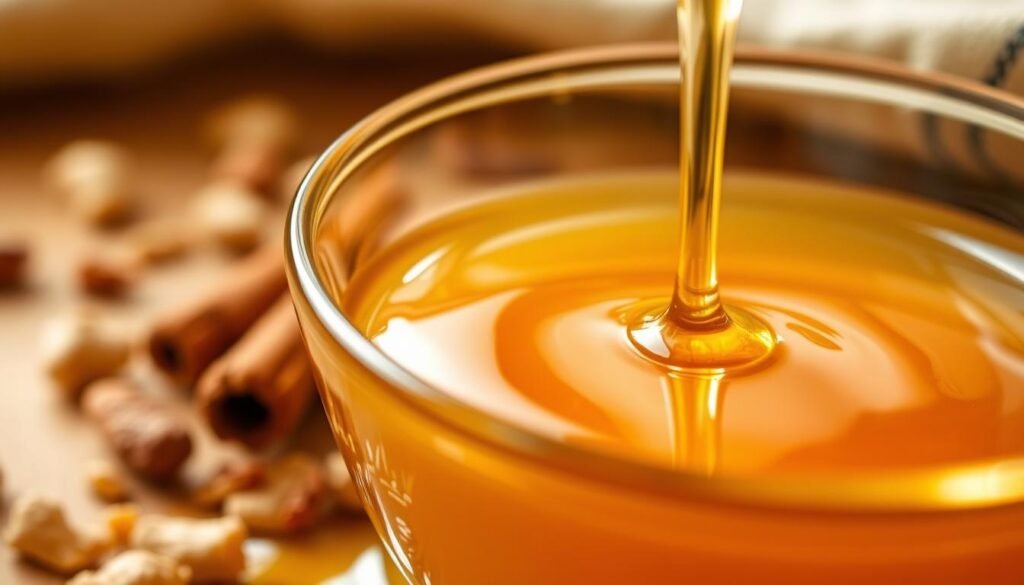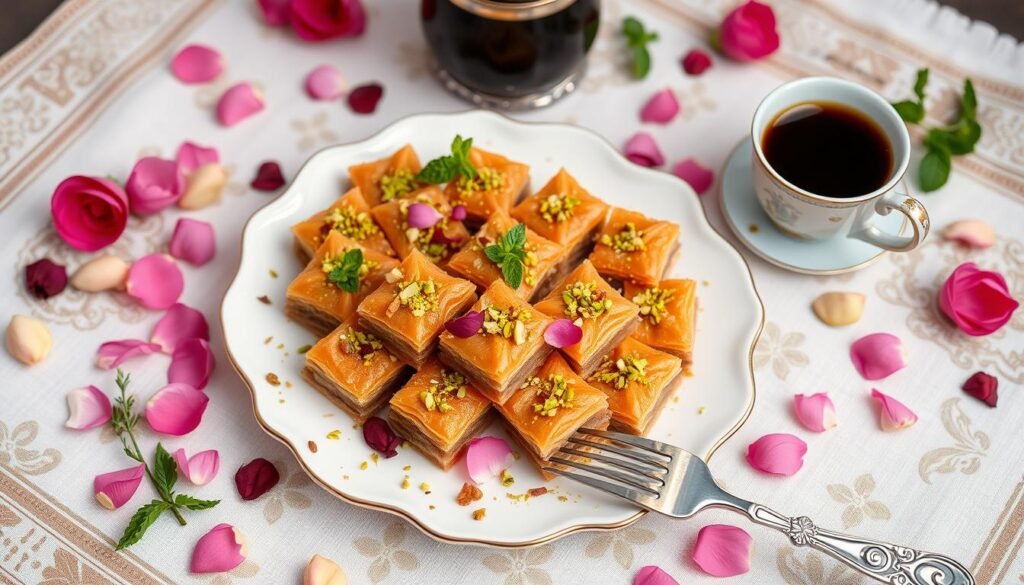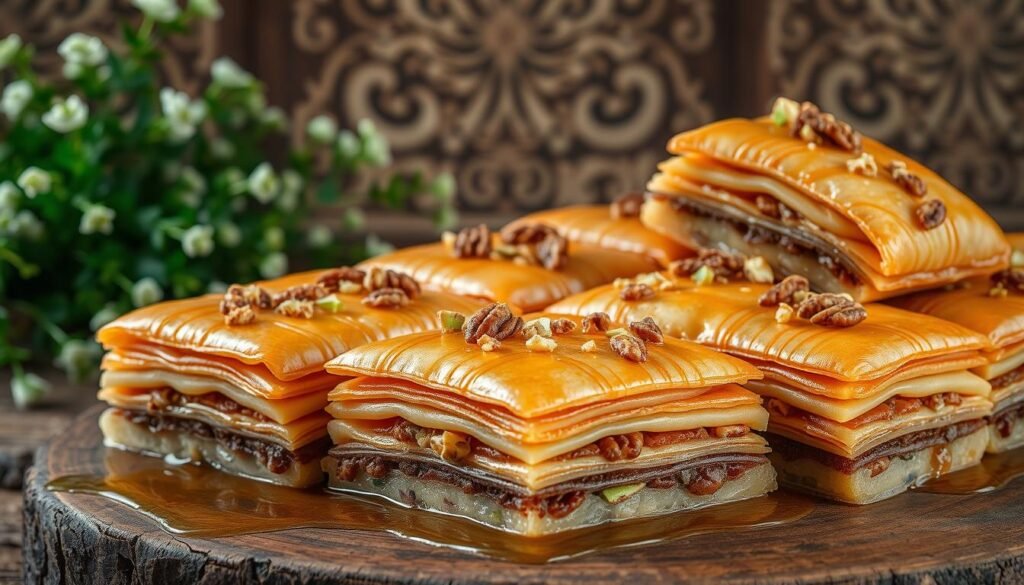I’m excited to share my love for Greek Baklava. It’s a traditional sweet pastry that’s both sweet and nutty. It has layers of flaky phyllo, crunchy nuts, and sweet honey syrup.
Imagine a sweet pastry that’s perfect for any occasion. That’s what Greek Baklava is all about. If you’re a foodie or just looking for a new dessert, this article is for you. It will guide you through the world of Greek Baklava and give you an easy recipe to make at home.
I’ll show you how to make this amazing sweet pastry. We’ll cover the essential ingredients and the perfect layering technique. So, you can make your own Greek Baklava at home and enjoy this sweet, nutty delight.
The Rich Heritage of Greek Baklava
Greek cuisine is famous for tasty pastries, and Baklava is a top favorite. It comes from the Mediterranean and has been loved for centuries. Let’s dive into its history and why it’s so special.
Greek Baklava’s story goes back to ancient Greece. It uses nuts, honey, and phyllo dough, common in Greek food. Over the years, it has become a favorite dessert in the Mediterranean.
Greek Baklava is more than a sweet treat. It shows Greek hospitality and tradition. It’s often enjoyed at weddings and holidays, bringing people together.
Origins in the Mediterranean
The Mediterranean is where Greek Baklava comes from. It’s made with phyllo dough, nuts, and honey, typical of Mediterranean food. Baklava has stayed a favorite, keeping its rich heritage alive.
Cultural Significance in Greek Cuisine
Baklava is a big deal in Greek food. It’s a sign of tradition and welcome. It’s a hit at special events, where it’s shared with loved ones.
Regional Variations
While everyone loves Greek Baklava, each place has its own twist. Different nuts and spices make each version unique. Exploring these variations shows the diversity of Greek cuisine.
| Region | Ingredients | Preparation Method |
|---|---|---|
| Athens | Walnuts, honey, phyllo dough | Layered phyllo dough with nuts and honey |
| Thessaloniki | Almonds, sugar, phyllo dough | Layered phyllo dough with nuts and sugar |
| Crete | Pistachios, honey, phyllo dough | Layered phyllo dough with nuts and honey |
Essential Ingredients for Authentic Greek Baklava
To make real Greek Baklava, you need a few key things. These are phyllo dough, nuts, and honey. The quality of these is very important for your Baklava to turn out right.
When picking phyllo dough, choose a good brand. It should be fresh and not frozen for too long. For nuts, almonds and walnuts are the best choice for flavor.
The honey you pick is also key. Greek Baklava uses pure, high-quality honey. Don’t use honey with added sugars. With the right ingredients, you can make a tasty Greek Baklava at home.
It’s also important to follow a traditional Greek Baklava recipe. This makes sure your Baklava tastes right. With practice and patience, you can make a delicious Greek Baklava that will wow your loved ones.
| Ingredient | Quantity | Importance |
|---|---|---|
| Phyllo dough | 1 package | High |
| Nuts | 1 cup | High |
| Honey | 1/2 cup | Medium |
My Secret Tips for Perfect Phyllo Handling
Handling phyllo is key to making great Greek baklava. I’ve learned that it’s all about technique and patience. Keeping the right temperature is crucial for perfect layers.
Phyllo needs to be at the right temperature. If it’s too warm, it tears easily. If it’s too cold, it’s hard to work with. The right temperature makes phyllo easy to handle.
Temperature Control Techniques
For the best temperature, keep phyllo in the fridge overnight. Then, let it sit at room temperature for 30 minutes before using. This makes it soft and easy to work with.
Also, keep your workspace at 70-75°F. This stops the phyllo from getting too warm or cold.
Preventing Tears and Breaks
It’s also important to avoid tears and breaks. Handle the phyllo gently and don’t stretch it too much. A soft touch and quick work helps keep layers even and intact.
Creating the Perfect Nut Filling
To make delicious Greek Baklava, you need a great nut filling. I mix walnuts and pistachios for mine. Walnuts give a rich flavor, and pistachios add crunch.
I chop the nuts into small pieces first. This lets their flavors and textures come out. Then, I mix them with sugar and spices. This makes a sweet and savory filling.
Remember, don’t overdo the nut filling. You want the nuts to be the main attraction. But, you also want the sugar and spices to be just right. A little goes a long way, so add more if you need to.
Using high-quality ingredients is key. Fresh walnuts and pistachios make a big difference. They give your baklava a richer flavor. So, choose the best ingredients you can find.
The Art of Layering Greek Baklava
Layering Greek Baklava needs patience and skill. Phyllo dough is key. It makes the dessert.
For great layers, balance phyllo and nuts. Start with a thin phyllo layer, then nuts. Repeat, adding more phyllo and nuts.
Bottom Layer Technique
The bottom layer is important. Brush phyllo with melted butter. This keeps it moist.
Middle Layer Strategy
The middle layer gets thicker phyllo and more nuts. Brush with butter for a golden look.
Top Layer Perfection
The top layer is thin and crispy. Brush with butter for a golden finish.
Follow these steps for a stunning Greek Baklava. Handle phyllo carefully. Try different layers to find your favorite.
Making the Signature Syrup
To make the perfect Greek Baklava, you need a sweet and fragrant syrup. The sugar-to-honey ratio is key. It gives the syrup a unique flavor.
I found that mixing sugar and honey syrup makes it rich and smooth.
Sugar-to-Honey Ratio
Finding the right sugar-to-honey ratio is important. I tried different mixes. A balance of sugar and honey syrup works best.

Aromatics and Spices
Aromatics and spices also matter a lot. Adding cinnamon and cloves makes the syrup fragrant and tasty. It pairs well with the honey syrup.
Baking and Cooling Methods
To make Greek Baklava crispy and golden, bake it at 350°F for 45 minutes. This makes the phyllo layers golden. Be careful, as it can burn quickly.
After baking, let the Baklava cool completely. This step is important. It lets the syrup set and flavors mix. Let it cool on a wire rack for 30 minutes before serving.
While cooling, heat the syrup in a saucepan over low heat. This makes it easier to pour over the Baklava. Pour the warm syrup over the cooled Baklava, covering it all.
Follow these steps for a delicious Greek Baklava. It will impress everyone. Be patient, as the effort is worth it.
Traditional Serving Suggestions
There are many ways to serve Greek Baklava. It’s often served as a dessert with coffee or tea. The sweetness of Baklava goes well with the bitterness of coffee or tea.
Baklava can also be a snack or appetizer. Try it with cheeses like feta or goat cheese. Or, serve it with fresh fruits like grapes or berries. The goal is to balance the sweetness of Baklava with savory flavors.
Accompaniment Options
Here are some great things to go with Greek Baklava:
| Accompaniment | Description |
|---|---|
| Coffee or Tea | A classic combination that pairs the sweetness of Baklava with the bitterness of coffee or tea |
| Feta Cheese | A salty and tangy cheese that complements the sweetness of Baklava |
| Fresh Fruits | A selection of fresh fruits, such as grapes or berries, that add natural sweetness and flavor to the dish |
Storage Tips
To keep Baklava fresh, store it in an airtight container. Keep it away from sunlight and moisture. This keeps the phyllo dough crunchy and the nuts fresh.
Freezing Baklava is another good idea. Wrap it tightly in plastic or foil and freeze. When you want to serve it, thaw at room temperature or reheat in the oven.

Common Mistakes to Avoid
When making Greek Baklava, it’s easy to make mistakes. Temperature is very important. It affects the dough and nuts.
Don’t let the dough get too hot or cold. This makes it hard or soggy. Also, let the syrup cool down before adding it. This prevents a soggy or too sweet dessert.
To avoid mistakes, follow a good recipe. Pay attention to temperature and other issues. This way, you’ll make a delicious dessert that everyone will love.
Temperature Issues
Temperature is key when making Greek Baklava. If the dough is not thawed right or gets too hot, it can be bad. This ruins the texture and taste of the dessert.
Syrup Timing
Not letting the syrup cool down is another mistake. This makes the dessert soggy and too sweet. It’s a big disappointment after all the work.
Cutting Problems
Cutting the baklava into diamonds can be hard. This is because it needs to cool down first. Let it cool completely before cutting.
| Mistake | Solution |
|---|---|
| Temperature issues | Follow a tried-and-true recipe and take the time to understand the techniques involved in making Greek Baklava |
| Syrup timing | Allow the syrup to cool properly before pouring it over the baklava |
| Cutting problems | Allow the baklava to cool completely before cutting it into pieces |
Conclusion: Mastering the Art of Greek Baklava
As we end our journey into Greek Baklava, I hope you now love this pastry more. You also feel ready to master the art of making it at home. The easy recipe and tips I shared will help you make this sweet, nutty delight for your loved ones.
Whether you’re new to baking or have lots of experience, mastering Greek Baklava is easy. Learn how to handle phyllo, make the nut filling, and get the syrup just right. Soon, your homemade Baklava will be as good as any you’ve tried.
So, use what you’ve learned and start baking. Enjoy making it, taste the yummy results, and share it with your friends and family. Happy baking!

